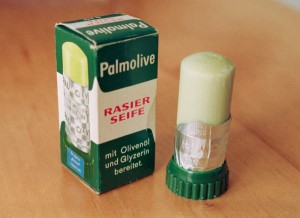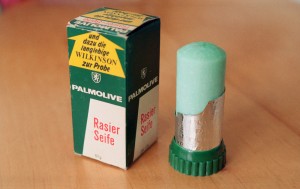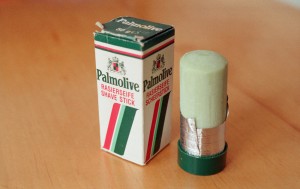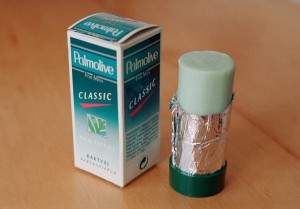I was lucky to find a collection of four different Palmolive Rasierseife sticks at a thrift store, all still sealed and unused. Age ranges from around 1950 to the 1990s. For comparison, I also bought the modern version (2018) of the stick. This is more of an experimental or archeological project, if you will. I was interested in how packaging, scent and other characteristics developed over the ages.

From left to right, we have sticks from around 1950 (1), 1960 (2), 1970s (3), 1990s (4) and the current make from 2018 (5) for comparison. If anyone can pin point the dates better, let me know.
Palmolive Rasierseife mit Olivenöl und Glyzerin bereitet (1)
 This 59 gram stick comes in aluminium wrapping, packaged in a cardboard box. The aluminium wrapping has an embossed text spelling Palmolive Binder & Ketels. According to a label, price was DM 1,10 back then. It has a knurdled green plastic grip, the soap itself is of light, slightly olive green color. The top of the stick is rounded. The alumnium embossing Palmolive Binder & Ketels indicates that this stick was manufactured before 1953, because the company was renamed to Colgate-Palmolive at this point. Since the price tag gives a price in DM, it was manufactured after 1945. The smell is quite soapy and with a comparatively strong scent of lemon. It makes a soapy foam with only very little smell (soapy and slightly lemonic, but much less so than the stick itself). There is no list of ingredients printed on the packaging.
This 59 gram stick comes in aluminium wrapping, packaged in a cardboard box. The aluminium wrapping has an embossed text spelling Palmolive Binder & Ketels. According to a label, price was DM 1,10 back then. It has a knurdled green plastic grip, the soap itself is of light, slightly olive green color. The top of the stick is rounded. The alumnium embossing Palmolive Binder & Ketels indicates that this stick was manufactured before 1953, because the company was renamed to Colgate-Palmolive at this point. Since the price tag gives a price in DM, it was manufactured after 1945. The smell is quite soapy and with a comparatively strong scent of lemon. It makes a soapy foam with only very little smell (soapy and slightly lemonic, but much less so than the stick itself). There is no list of ingredients printed on the packaging.
Palmolive Rasier-Seife (2)
 Still the same knurdled plastic grip, still a round top. Price has risen to DM 1,25. The embossing in the aluminium foil wrapping now shows a logo with a lion and the text Palmolive. The same lion logo is also printed on the cardboard packaging. The color now is a bit more saturated greed. The smell is very similar to the first cream (1), quite soapy and lemony. Again, no list of ingredients.
Still the same knurdled plastic grip, still a round top. Price has risen to DM 1,25. The embossing in the aluminium foil wrapping now shows a logo with a lion and the text Palmolive. The same lion logo is also printed on the cardboard packaging. The color now is a bit more saturated greed. The smell is very similar to the first cream (1), quite soapy and lemony. Again, no list of ingredients.
Palmolive Rasierseife Shave Stick (3)
 For this version, the grip has changed to the smooth style that is known from the modern version. The top of the soap stick is still rounded. Package size has gone from 59 grams to 50 grams. On the cardboard box there is logo with one lion on each side. The aluminum wrapping does not have any lion logo anymore, it only reads Palmolive. Manufacturer is listed as Colgate-Palmolive, Belgium/Brussels. There is a recycling symbol printed on the cardboard packaging, which means it was manufactured after 1970. The soap is of more subtle olive green color again, similat to (1). The smell is still quite soapy and lemony, bit with a less soapy scent than verions (1) and (2). There is more of a perfume note and the foam is finer and more creamy. Again, no list of ingredients.
For this version, the grip has changed to the smooth style that is known from the modern version. The top of the soap stick is still rounded. Package size has gone from 59 grams to 50 grams. On the cardboard box there is logo with one lion on each side. The aluminum wrapping does not have any lion logo anymore, it only reads Palmolive. Manufacturer is listed as Colgate-Palmolive, Belgium/Brussels. There is a recycling symbol printed on the cardboard packaging, which means it was manufactured after 1970. The soap is of more subtle olive green color again, similat to (1). The smell is still quite soapy and lemony, bit with a less soapy scent than verions (1) and (2). There is more of a perfume note and the foam is finer and more creamy. Again, no list of ingredients.
Palmolive For Men Classic Rasierseife (4)
 Here the top has changed from rounded to flat. Package size is still 50 grams. The aluminium foil packaging now is just smooth high gloss foil with no embossing or printing on it. The color of the soap stick now is a very soft green with a hint of blue, very similar to the current modern version. The smell has become less soapy and notably more etheric, even more softer and refined than version (3). Manufacturer is Colgate-Palmolive, Belgium/Liege. There is a green dot recycling symbol printed on the packaging, which means it was made after 1990. Ingredients: Potassium Stearate, Potassium Palmitate, Sodium Tallowate, Sodium Cocoate, Sodium Stearate, Aqua, Glycerin, Parfum, Olea Europaea, Elaeis Guineensis, Tetrasodium EDTA, Tetrasodium Etidronate, BHT, Cl 11680, Cl 12490, Cl 74260, Cl 77891.
Here the top has changed from rounded to flat. Package size is still 50 grams. The aluminium foil packaging now is just smooth high gloss foil with no embossing or printing on it. The color of the soap stick now is a very soft green with a hint of blue, very similar to the current modern version. The smell has become less soapy and notably more etheric, even more softer and refined than version (3). Manufacturer is Colgate-Palmolive, Belgium/Liege. There is a green dot recycling symbol printed on the packaging, which means it was made after 1990. Ingredients: Potassium Stearate, Potassium Palmitate, Sodium Tallowate, Sodium Cocoate, Sodium Stearate, Aqua, Glycerin, Parfum, Olea Europaea, Elaeis Guineensis, Tetrasodium EDTA, Tetrasodium Etidronate, BHT, Cl 11680, Cl 12490, Cl 74260, Cl 77891.
Palmolive Men Classic with Palm Extract (5)
 This 2018 model is almost identical to the model I tested before in 2015 (visit blog post for details), it has the same ingredients. It has the flat top, the light green (with a hint of blue) color and the smooth base. The aluminium foil wrapping has a pattern of fine checkered lines embossed into it, giving it a more dull metallic appearance. Compared to the older versions, is has an even less soapy scent and a very smooth, slighly oily, creamy foam. There seems to be more perfume, with an even softer and more refined smell than the old versions.
This 2018 model is almost identical to the model I tested before in 2015 (visit blog post for details), it has the same ingredients. It has the flat top, the light green (with a hint of blue) color and the smooth base. The aluminium foil wrapping has a pattern of fine checkered lines embossed into it, giving it a more dull metallic appearance. Compared to the older versions, is has an even less soapy scent and a very smooth, slighly oily, creamy foam. There seems to be more perfume, with an even softer and more refined smell than the old versions.
Summary
The change in optical style over the decades is unmistakably.
The smell seems to have progressed from soapy and lemony to a more refined, less soapy, less lemony, more etheric and refined smell.
The foam has progressively gone from soapy to more creamy. It is of course questionable if this was an actual change in the product, or if the different scent and foaming is because of the different ages of the shaving sticks.
One of the older creams seemed to cause my foaming brush to develop a slightly rancid smell after some time, which may point to some fats in the soap having gone bad. To be sure there was no health risk, I sent a portion of the oldest stick (1) to a hygienic lab for analysis: they did not find anything objectionable with regards to bacteria or mold. This means even old soaps can probably be used without risk (assuming they have been stored properly), but there may be some changes in fragrance.
So which one is the best? Since I’m not a big Palmolive soap fan I find that very hard to answer. The older ones are more basic and soapy, but too lemony for my taste. The modern ones almost have a hint too much perfume for my taste.
